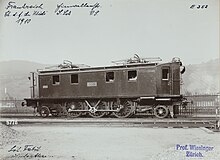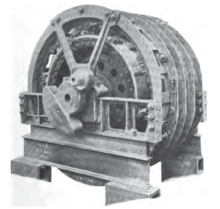
The SNCF BB 26000 locomotives are a class of dual voltage, four axle B'B' electric locomotives capable of a top speed of 200 km/h built by GEC Alsthom between 1988 and 1998 for SNCF. The locomotives are also commonly known as the Sybics.

The Ae 6/6 is a heavy electric locomotive used by the Swiss Federal Railways (SBB-CFF-FFS). It is sometimes also referred to as canton locomotive ("Kantonslokomotive"), because the first 25 locomotives were named after the cantons, and carried the canton's coat of arms on the side and chrome embellishments, and the Swiss coat of arms on the front, between the chrome stripes. These adornments made them internationally famous. The other 95 locomotives received the names of capital cities of Swiss cantons, and other towns and cities, but without the chrome embellishments. The namings were held as ceremonies in the respective cities. A less appealing moniker is Schienenwolf as the three axle bogie construction stresses the tracks heavily.

The Buchli drive is a transmission system used in electric locomotives. It was named after its inventor, Swiss engineer Jakob Buchli. The drive is a fully spring-loaded drive, in which each floating axle has an individual motor, that is placed in the spring mounted locomotive frame. The weight of the driving motors is completely disconnected from the driving wheels, which are exposed to movement of the rails.
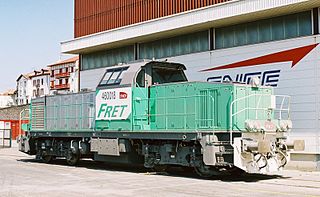
The SNCF Class BB 60000 are a class of 4 axle heavy shunting and light freight diesel–electric locomotives built at the Vossloh España works in Valencia. Since the class is primarily used as a freight locomotive the class is commonly referred to as SNCF BB 460000.
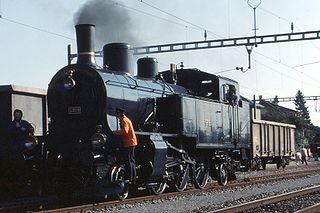
For more than a century, the Swiss locomotive, multiple unit, motor coach and railcar classification system, in either its original or updated forms, has been used to name and classify the rolling stock operated on the railways of Switzerland. It started out as a uniform system for the classification and naming of all rolling stock, powered and unpowered, but had been replaced and amended by the UIC classification of goods wagons.

The Voralpen-Express (VAE) is a named train connecting small to medium-sized cities and villages in Central and Eastern Switzerland, carrying this name since 1992. It is operated by Südostbahn (SOB) and runs every hour as an InterRegio (IR) between St. Gallen and Lucerne, bypassing Zurich. Its name derives from the fact that it traverses the Prealps.

The Südostbahn – commonly abbreviated to SOB – is a Swiss railway company, and a 1,435 mmstandard gauge network in Central and Eastern Switzerland. It resulted from the merger of the original SOB with the Bodensee–Toggenburg railway (BT) at the end of 2001.
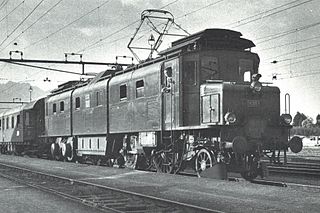
The Ae 4/8 was a prototype locomotive of the Schweizerischen Bundesbahnen (SBB) for the testing of electrical operation. The locomotive was equipped with two different drives, therefore acquiring the nickname Bastard. Because of its three-part locomotive body it also acquired the nickname Tatzelwurm.

The Be 3/5 11201 was one of four test locomotives ordered by the Schweizerischen Bundesbahnen (SBB) in June 1917. Intended to provide experience with electric traction, the locomotive was intended, along with Be 4/6 12301, Be 4/6 12302 and Ce 6/8I14201, to be used on services on the Gotthardbahn. The Be 3/5 was something of a stopgap offered by Maschinenfabrik Oerlikon (MFO) because they felt that the requirements required for the Gotthard Railway could not be fulfilled at the time. As the MFO did not feel that it could produce a freight locomotive with six drive-axles, a smaller version of the BLS Be 5/7 was offered. This meant that the locomotive did not fulfil the SBB specifications for the Gotthard line; it was too weak and, compared with the A 3/5 steam locomotives, too slow. However, due to a lack of available stock, the railway still took delivery of the locomotive, a decision later proved correct by the long operational life and reliability of the Be 3/5.
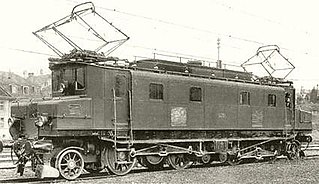
The Be 4/6 12301 was one of four test locomotives ordered by the Schweizerische Bundesbahnen (SBB) in June 1917. For gaining experience for ordering electrical locomotives this locomotive should – as her three sisters Be 3/5 12201, Be 4/6 12302 and Ce 6/8I14201 – have been used for services on the Gotthardbahn. The Be 4/6 12301 was the alternative design of MFO for a fast train locomotive for the Gotthard railway line. She was designed and built according to the requirement specifications of the SBB. But – except for occasional trips to the maintenance shop of Bellinzona – did not appear on the Gotthard railway line. The design was intrinsically reliable. The locomotive operated for 44 years in very various services. The locomotive drivers liked the locomotive because her driving behaviour was very smooth even at top speed. But technically the locomotive was much more complicated than their sisters Be 4/6 12302 and Be 4/6 12303-12342.

The Be 4/6 12302 was one of four test locomotives ordered by the Schweizerische Bundesbahnen (SBB) in June 1917, along with the Be 3/5 12201, Be 4/6 12301 and Ce 6/8I14201. It was intended to be used on the Gotthardbahn, in order to gain experience in ordering and operating electric locomotives, However, the Be 4/6 12302 was never used for scheduled services on the Gotthard, because at its introduction it was already outperformed by the successor class Be 4/6 12303-12342.
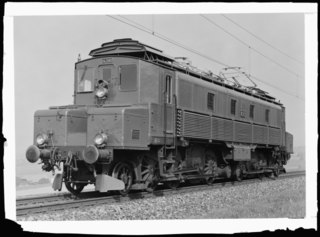
The Ce 6/8 I 14201 was one of four test locomotives ordered by the Schweizerischen Bundesbahnen (SBB) in June 1917. For gaining experience for ordering electrical locomotives this locomotive should – as its three siblings Be 3/5 12201, Be 4/6 12301 and Be 4/6 12302 – have been used for services on the Gotthardbahn. The development of freight locomotives subsequently took a completely different way which was not conceivable at the ordering date. The Ce 6/8I came into service only after the first Ce 6/8II.

The SBB-CFF-FFS Ae 8/14 is a class of electric locomotives built for Swiss Federal Railways to be used on the Gotthard railway. Only three prototype engines were built between 1931 and 1938, each of them in a different design.

Erstfeld railway station is a railway station in the Swiss canton of Uri and municipality of Erstfeld. The station is situated on the original line of the Gotthard railway, at the foot of the ramp up to the Gotthard Tunnel. The original line, and the newer line through the Gotthard Base Tunnel meet at a junction some 1.5 kilometres (0.93 mi) north of, and downhill from, Erstfield station. Most trains on the Gotthard route now use the base tunnel and therefore do not pass through the station.

The Be 4/6 was a bogie locomotive operated by the Schweizerischen Bundesbahnen (SBB) on the Gotthard Railway along with the Be 3/5, The design was based on the prototype Be 4/6 12302.
A monomotor bogie is a form of traction bogie used for an electric locomotive or diesel-electric locomotive. It is distinguished by having a single traction motor on each bogie.

The Swiss locomotive class Ae 4/6 was a class of electric locomotives. They were intended as a powerful locomotive for the steep gradients of the Gotthard Railway, but smaller than the huge 'double locomotives' which had previously been tested there. They were built from 1941, during World War II, and although Switzerland remained neutral through this, material shortages led to some quality problems with these locomotives.
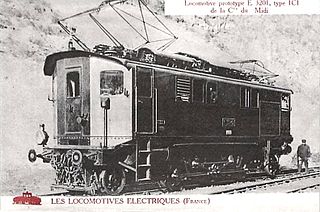
1C1 3900 was a class of SNCF electric locomotive. The class had only one member, 1C1 3901. It was built in 1912 for the Chemins de fer du Midi and its Midi class was E 3200. It was one of six different prototype electric locomotives ordered by the Midi. It was withdrawn in 1959 and one motor from it is preserved.

Rigid-framed electric locomotives were some of the first generations of electric locomotive design. When these began the traction motors of these early locomotives, particularly with AC motors, were too large and heavy to be mounted directly to the axles and so were carried on the frame. One of the initial simplest wheel arrangements for a mainline electric locomotive, from around 1900, was the 1′C1′ arrangement, in UIC classification.
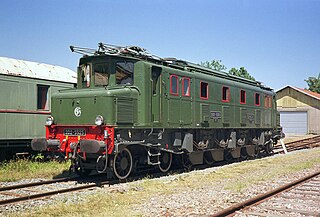
The 2D2 5500 were electric locomotives operated by the Compagnie du chemin de fer de Paris à Orléans, then SNCF in France, in operation from 1933 to 1980.


